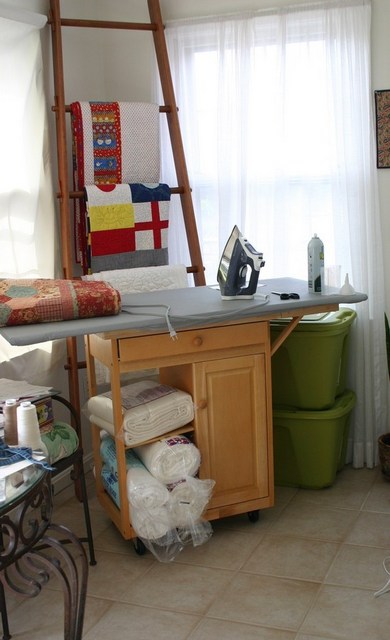 Following last week's tip, we received a number of additional great ideas for creating your own custom ironing board. From suggestions for adapting kitchen and office furniture, to a quick and portable ironing surface for workshops, the variety of ideas was astounding.
Following last week's tip, we received a number of additional great ideas for creating your own custom ironing board. From suggestions for adapting kitchen and office furniture, to a quick and portable ironing surface for workshops, the variety of ideas was astounding.
- Using last week's instructions for a custom board design, make a board that measures 24" x 60". Place the board on the floor, padded side down. Center a commercial ironing board, face down and with legs folded in, on the prepared board. Trace around the commercial board. Remove the commercial board, and use wood glue (or screws if you are handy) to attach two scraps of wood on each side and one scrap of wood on each end of the ironing-board outline (just outside the traced drawing). Secure with wood clamps until the glue is dry. When dry, place your custom board on top of the commercial board. The wood scraps will hold the custom board in place, and you now have a large, stable ironing surface. (Submitted byJo Ann Cross)
- Place your custom board on top of a small 3-drawer dresser. "I bought the dresser at a thrift store. I got it for a steal because the top was dented." (Submitted by Sue Singer)
- "I made my custom board out of MDF, placed a layer of heat reflective film (silver batting used in cooking pads) on top and covered the whole thing in canvas." (Submitted by Julia Grigsby)
- Place the custom board on top of an inexpensive, but sturdy, kitchen cart with locking wheels. The ironing board can be rolled to wherever it is needed. (Submitted by Kelley Cunningham)
- Ask for an empty fabric bolt at your local quilt store. Fold a 24"x16" piece of 100%-cotton flannel in half to make a 24"x 8" sleeve. Pin and stitch across one short end. Insert the cardboard bolt inside the sleeve and pin up the long side as tightly as possible. Remove the cardboard bolt and stitch up the pinned side.Turn inside out. Slide the cardboard bolt into the sleeve opening; it should be a nice tight fit. ***Please note that this is meant to be a temporary ironing surface for workshops or retreats, not a primary ironing surface*** (Submitted by Kandy Newton)




.jpg)


